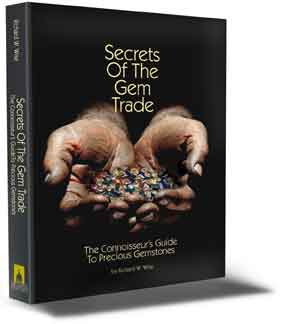 by Richard W. Wise
by Richard W. Wise
©2007
Al Gilbertson, G.G.
The Gemological Institute of America
Paperback, 214 Pages. $29.95
American Cut, The First 100 Years, sets the record straight. Al Gilbertson tells the true story of the development of the ideal cut round brilliant diamond. First, Gilbertson clears away the prevailing myth endlessly repeated by industry writers, including this one, that Marcel Tolkowsky was the first to articulate the proper proportions for fashioning a round brilliant cut diamond.
Gilbertson has done his homework. He traces the origin of a finely cut diamond from its origins in Early European history to a maverick American jeweler by the name of Henry Morse. Morse, a jeweler not a cutter, opened a diamond cutting shop in Boston around 1860. Morse had the idea that improving the cut of a diamond would result in a more beautiful stone and that better looking stones would sell better. This revolutionary concept brought him in direct conflict with his own employees, diamond cutters educated in Europe where cutters were actually fined if they lost too much weight cutting a diamond.
The author makes the point, not unknown to young men shopping for an engagement ring today, that in diamonds, better meant bigger. From earliest times, European monarchs were in competition with one another to own the biggest diamonds. The ownership of a big rock was a status symbol that added luster to a reign not to mention being a highly portable source of ready money. Not everyone agreed, Louis XIV, the biggest gem collector of them all, ordered his jeweler, Pitau to recut the French Blue from a hefty 114 carats to a mere 66, a loss of 41%, simply to improve its sparkle.
Morse has the good luck to hire a fellow named Charles Field, as his shop foreman. Field invented a mechanical diamond bruting machine that replaced the old method of hand rounding, a laborious process of hand rubbing that required weeks to shape a single gem. Morse experimented with a series of cutting angles and by 1870 had discovered crown and pavilion angles that dramatically improved face-up appearance. Morse and Field then invented a gauge to be used by their cutters to achieve the true precursor of modern “ideal cut” round.
There is a whole lot more. Gilbertson takes us right to the present discussing the influence of Tolkowsky and American pioneer gemologists, Frank Wade and GIA founder Robert Shipley. Gilbertson’s own insights into beauty and diamond cutting are of real interest. He was part of the team that researched over 70,000 sets of proportions that led to the new GIA diamond cut evaluation system and knows whereof he speaks.
Profusely illustrated, well researched and thoughtfully written, American Cut, The First 100 Years gives us the real story. It is one of those books that deserve a place of every gemologist’s library. At $29.95 it is a bargain. Order here
Ordered American Cut, The First 100 Years? Still have a few dollars left?
Follow me on gem buying adventures in the pearl farms of Tahiti. Visit the gem fields of Australia and Brazil. 120 carefully selected photographs showing examples of the highest quality gems to educate the eye, including the Rockefeller Sapphire and many more of the world’s most famous gems. Consider my book: Secrets Of The Gem Trade, The Connoisseur’s Guide To Precious Gemstones.
educate the eye, including the Rockefeller Sapphire and many more of the world’s most famous gems. Consider my book: Secrets Of The Gem Trade, The Connoisseur’s Guide To Precious Gemstones.
“Wise is a renowned author… He’s
done a marvelous job of this first book, monumental work, a tour de force…My recommendation: Buy this book”.
Charles Lewton-Brain, Orchid
whether you like to know what the best colour is in Tanzanite, or how to grade a Diamond, you will find it in this book. No other book I read before dealt with this topic is such detail as Richard Wise’s masterpiece.”
A. Van Acker, FGA
Amazon June 2005
“Secrets Of The Gem Trade: The Connoisseurs Guide To Precious Gemstones by Richard W. Wise is an impressive new reference for dedicated dealers and collectors of gems, gemstones, and … pearls. Introducing and descriptively exploring each and every gem covered in the easy-to-use reference, Secrets Of The Gem Trade contains an illustrated summary of each stone inclusive of its history and general information, hue and tone, saturation, which may be noticed as the finest, an understanding of the particular gems rarity, and the caution for synthetics and how to depict them, however depending upon the stone there may be description of clarity, color fading, multi-color effect, etc. Secrets Of The Gem Trade is very highly recommended to anyone interested in gemology as a superbly organized, authoritative, comprehensive, and easy-to-follow reference.”
Midwest Book Review
April 2006
Only $37.95. Read a couple of chapters online: www.secretsofthegemtrade.com.
Buy it on Amazon: www.amazon.com

